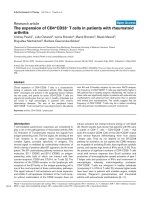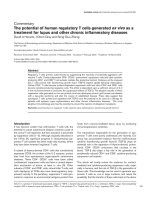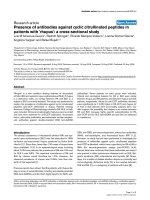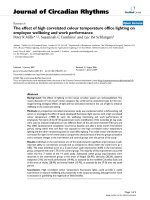Báo cáo y học: " The Iranian female high school students'''' attitude towards people with HIV/AIDS: a cross-sectional study" pot
Bạn đang xem bản rút gọn của tài liệu. Xem và tải ngay bản đầy đủ của tài liệu tại đây (214.2 KB, 5 trang )
BioMed Central
Page 1 of 5
(page number not for citation purposes)
AIDS Research and Therapy
Open Access
Research
The Iranian female high school students' attitude towards people
with HIV/AIDS: a cross-sectional study
Kamyar Ghabili*
1,2
, Mohammadali M Shoja
1
and Pooya Kamran
3
Address:
1
Tuberculosis and Lung Disease Research Center, Tabriz University of Medical Sciences, Daneshgah St., Tabriz, Iran,
2
Students' Research
Committee, Tabriz University of Medical Sciences, Attar Neishabouri Ave., Golgasht St., Tabriz, Iran and
3
Faculty of Medicine, Tabriz University
of Medical Sciences, Daneshgah St., Tabriz, Iran
Email: Kamyar Ghabili* - ; Mohammadali M Shoja - ; Pooya Kamran -
* Corresponding author
Abstract
Background: Acquired Immunodeficiency Syndrome (AIDS) has become an important public
health hazard in Iran. It is believed that AIDS-related knowledge does not necessarily translate into
behavior modification. Hence, it has been suggested that culturally appropriate educational
campaigns should be implemented to obtain satisfactory outcomes. Here, we evaluated the female
high school students' attitude towards HIV/AIDS in Tabriz, Iran to assess the cultural needs for the
related educational programs and to discover sources of information about AIDS.
Results: Anonymous, self-administered questionnaires were filled by the young female students.
Among 300 students, 91% agreed that being an HIV carrier should not be an obstacle to obtaining
education and employment. Moreover, 72.5% of the students declared that the community should
be informed of HIV-positive people. In addition, one-tenth declared that they would feel extremely
uncomfortable towards their HIV infected classmate. In addition, only 16% of the students stated
that they would continue to shop at HIV infected grocer's store. The mass media and the experts
were the major source and the most reliable source of information about AIDS, respectively.
Conclusion: Tabrizian female students have overall negative attitudes towards HIV/AIDS. HIV/
AIDS related educational campaigns should target the students, society and the families with
emphasizing the leading roles of health staff.
Background
Acquired Immunodeficiency Syndrome (AIDS) is among
the most serious health problems of the 21
st
century [1].
In Iran, the first case of Human Immunodeficiency Virus
(HIV) infection was reported in 1987. This was followed
by a rapid increase in the number of infected cases [2]. In
2004, there were officially 6532 Iranians living with HIV/
AIDS, of which 95% were male [3]. This figure was
increased to 16090 HIV positive individuals (94.6%
male) in 2007. According to the recent report from Iran,
66.7% of AIDS patients are intravenous drug users, while
30% are infected by sexual contact [4]. Nevertheless, it is
believed that these data underestimate the real number of
HIV/AIDS cases [3]. Hence, the issue has become an
important public health problem and several AIDS-
related educational programs have been targeted on vari-
ous populations including university and high school stu-
dents [1,3].
Published: 22 July 2008
AIDS Research and Therapy 2008, 5:15 doi:10.1186/1742-6405-5-15
Received: 11 April 2008
Accepted: 22 July 2008
This article is available from: />© 2008 Ghabili et al; licensee BioMed Central Ltd.
This is an Open Access article distributed under the terms of the Creative Commons Attribution License ( />),
which permits unrestricted use, distribution, and reproduction in any medium, provided the original work is properly cited.
AIDS Research and Therapy 2008, 5:15 />Page 2 of 5
(page number not for citation purposes)
Health education and prevention remain the main health
care priorities in AIDS prevention [1]. It might be sup-
posed that accurate knowledge of AIDS would reduce the
risk behavior [1,2,5]. Nonetheless, numerous studies
unveil that having adequate knowledge of HIV/AIDS does
not necessarily translate into behavior modification [6-
10]. Therefore, it has been suggested that culturally appro-
priate AIDS-related educational campaigns should be
implemented to obtain satisfactory outcomes [9-11].
Moreover, the outcome of the educational campaigns
focusing on the AIDS-related topics may be improved at
schools if the level of the students' attitude is initially
determined [1]. Although various studies have been per-
formed worldwide to ascertain the students' knowledge
and attitude towards HIV/AIDS, no comprehensive survey
has been carried out among the Iranian students to assess
their attitude towards this disease. Therefore, the current
study aimed at evaluating the female high school stu-
dents' attitude towards HIV/AIDS in Tabriz, Iran to assess
the cultural needs for the related educational programs
and to discover the sources of information about AIDS.
Results
Three hundred female high school students from the
fourth grade participated in the present study. The mean
age of the respondents was 17.9 +/- 0.16 years (range 17–
22). Two hundred and seventy three students (91%)
agreed that being an HIV carrier should not be an obstacle
to obtaining education and employment. The majority of
the respondents (93%) believed that the community in
which they were living was not protected from AIDS. Two
hundred and sixty respondents (86.3%) recommended
that special hospitals should be built for AIDS patients.
Interestingly, 217 of the students (72.5%) declared that
the community should be informed of HIV-positive peo-
ple in order to strengthen the social awareness of potential
source of the infection. Seventy seven students (25.5%)
stated that they were not interested in having a friend who
was an HIV carrier, whereas 83 respondents (27.5%)
expressed that it would make no difference to have such a
friend. Furthermore, only six students (2%) dissented
from abortion of the HIV infected fetuses. Nearly one-
tenth of the respondents disagreed with sending the HIV-
positive children to special classes. A list of questions with
the percentage of each response is provided in Table 1.
The mean attitude score was 59.9 out of 100 (SD = 7.8,
range 41 to 79). Considering a score of 75 as the cut-off
point for a positive attitude, only 6% (n = 18) of the stu-
dents had a positive attitude towards HIV/AIDS. Among
the demographic items, educational level of father had a
negative correlation with the attitude score (r = -0.131; p
Table 1: The questionnaire and respondents' attitude towards HIV/AIDS (n = 300).
Question Totally agree (%) Agree (%) Neutral position (%) Disagree (%) Totally disagree (%)
1. AIDS is the disease of the poor. 2 2 13.7 51 31.3
2. Most HIV-positive individuals are responsible for the
acquisition of the infection.
13.7 29.4 5.9 35.3 15.7
3. Our community is protected from AIDS. 2 2 3 39.2 53.8
4. AIDS is a major hazard of the present time. 41.2 35.3 13.7 7.8 2
5. I will not be afflicted with HIV during my whole life. 24 34 20 20 2
6. HIV-positive people should be isolated from the general
population.
14 12 12 40 22
7. Special hospitals should be created for AIDS patients. 56.9 29.4 9.8 2 2
8. AIDS patients should not receive education and
employment.
12 6 41 50
9. The community should be informed of HIV-positive
people.
31.3 41.2 11.8 9.8 5.9
10. Inefficacy of individuals leads them to acquire the AIDS. 9.8 13.7 23.5 37.3 15.7
11. I am not interested in having a friend who is a carrier of
HIV.
25.5 23.5 27.5 17.6 5.9
12. AIDS sufferers are considered as victims of the social
system.
13.7 43.1 23.5 15.7 3.9
13. AIDS patients should not take care of an orphan. 29.4 15.7 25.5 17.6 11.8
14. I would be responsible for caring an HIV-positive child. 4 20 42 16 18
15. The HIV tests should be voluntary and anonymous. 31.4 17.6 7.8 31.4 11.8
16. Most AIDS patients do not care if they infect other
people too.
24 42 18 14 2
17. Pregnant women should be tested for the HIV. 60.8 33.3 3.9 1 1
18. Fetuses infected with HIV should be aborted. 60.8 21.6 13.7 2 2
19. Children who are HIV carriers should be sent to special
schools/classes.
13.7 27.5 23.5 25.5 9.8
20. I feel sympathy towards AIDS patients. 8 28 46 10 8
AIDS Research and Therapy 2008, 5:15 />Page 3 of 5
(page number not for citation purposes)
< 0.05). We found no significant correlation between the
other demographic items (age, educational level of
mother, family's mean monthly income) and the attitude
score (p > 0.05).
In addition, the students were asked to suppose they
found out that one of their classmates was suffering from
AIDS. Only thirty respondents (10%) declared that they
would feel extreme discomfort for such a situation. Inter-
estingly, almost all the respondents (97.9%) stated that
they would stay at the same school where the HIV-positive
student was studying. Of these, one-fourth indicated that
they would discontinue having any contact with their
HIV-positive classmate, while more than half (52.1%)
declared that they would treat their classmate in a usual
manner. Two hundred and four students (68%) stated
that they would feel discomfort to know that the neigh-
borhood grocer had AIDS. Only 48 respondents (16%)
stated that they would continue to shop at that grocery
store.
The majority of the respondents (80%) indicated that the
mass media (radio, television and newspapers) was the
major source of their information about AIDS, followed
by school educational materials (books and educational
matters) (10%), and family and friends (10%). Further-
more, more than 75% of the students mentioned that they
would rely on an expert's information on HIV/AIDS. In
contrast, families and school teachers constituted the least
reliable sources of AIDS-related information, respectively
(3% and 2%).
Discussion
In the present study, we surveyed a group of Iranian
female high school students' attitude towards HIV-posi-
tive and AIDS patients. The overall findings from this
study indicated a relatively negative attitude towards HIV/
AIDS among Tabrizian female high school students. Sim-
ilarly, a previous survey by Tavoosi and colleagues on a
group of Iranian high school students in 2004 revealed an
intolerant attitude towards AIDS and HIV positive
patients [2]. Contrarily, Montazeri reported that Iranian
people showed a more positive attitude towards HIV/
AIDS than expected [3]. More than 40% of the students
believed that HIV infected children should be sent to spe-
cial schools/classes and not to regular classes. This is in
agreement with those of Tavoosi et al. [2] and Brook [12].
In comparison, Pita-Fernández et al. [8] and Gañczak et
al. [13] found the percentage of positive responses to a
similar item as 5% and 73%, respectively.
In this study, the respondents also expressed affirmative
attitudes towards some of the given items. In the current
survey, only a few students thought that being a carrier of
the HIV should be an obstacle to receiving education and
employment. This is comparable to the study of Pita-Fern-
ández and colleagues on a group of nurses in Spain [8].
Contrarily, in an earlier population-based study in Iran,
Montazeri reported that more than a tenth of the respond-
ents agreed that people with AIDS should not have right
to study or work [3]. One-quarter of our respondents
believed that HIV-positive people should be isolated from
the general population. However, a recent report by Maz-
loomy and Baghianimoghadam indicates that more than
55% of the Iranian teachers agreed or strongly agreed with
the similar statement [14].
The reports of rapid spread of HIV infection in different
populations have no doubt increased the level of anxiety
in the communities [2]. This may explain that why the
majority of the surveyed students believed that their com-
munity was not protected from AIDS. This finding is sim-
ilar to that of the survey by Tavoosi et al. on a group of
Iranian high school students in the capital city of Tehran
[2].
This study demonstrated that educational level of father
was inversely associated with the level of attitude towards
HIV/AIDS. The potential indications of this finding is
unclear to us, however, the paternal factors affecting the
attitudes of female students may demand further investi-
gation. No significant correlation was found between age
and the attitude score, well compared to the study by
Montazeri [3]. However, this finding is in contrast with
that of Mazloomy and Baghianimoghadam on a group of
Iranian schoolteachers that indicated a negative correla-
tion between age and the level of attitude [14].
The present study revealed that one-forth of the students
would discontinue having any contact with their infected
friend. In the study of Tavoosi et al., nearly one-third of
students declared that they would avoid sitting near an
infected student [2]. Surprisingly, in the study of Merakou
et al. only 5% of Greek students declared that they would
reject their infected friends [15]. Almost all the respond-
ents of the current survey stated that they would stay at the
same school where the HIV-positive student was studying.
This is consistent with that of the similar study by Mas-
wanya et al. indicating that 85% of the Japanese female
college students would be able to study in the same class
with HIV-positive classmates [16]. Moreover, in the
present study, less than three quarters of the surveyed stu-
dents felt discomfort about having an HIV-positive grocer
in the neighborhood.
The mass media (radio, television and newspapers) were
the most common means of obtaining information about
HIV/AIDS. This finding is consistent with those of Brook
[12], Tavoosi et al. [2] and Gañczak et al. [13]. However,
physicians constituted the most reliable sources of infor-
AIDS Research and Therapy 2008, 5:15 />Page 4 of 5
(page number not for citation purposes)
mation in our study. Hence, it seems that health profes-
sionals, in particular the physicians, should be involved in
HIV/AIDS educational programs in the similar settings.
Moreover, based on our results, the role of peer education
programs in Iranian schools focusing on HIV/AIDS
should be revised in order to set the most efficacious edu-
cations. Peer education programs have been started in Ira-
nian guidance schools and high schools and thousands of
students are being trained every year to educate their peers
on HIV/AIDS. Consultants and health workers in guid-
ance schools and high schools educate the selected stu-
dents for efficient peer education [17].
Conclusion
The overall findings from this study revealed an overall
negative attitude about HIV/AIDS among Tabrizian
female high school students. Based on the present study,
one may recommend that the currently implemented
HIV/AIDS related educational campaigns for the Iranian
students should be extended beyond the schools to the
society and families due to unsatisfactory role of families
in AIDS education and prevention. Furthermore, the lead-
ing roles of health staff including physicians should be
highlighted not only in HIV/AIDS educational programs
at schools, but also in the media, which at present is the
most frequent but not necessarily reliable source of infor-
mation.
Methods
This cross-sectional study was conducted in May 2005 in
Tabriz, a city located in Northwest of Iran. The study pop-
ulation consisted of female high school students from the
fourth grade who attended the educational institutes
throughout Tabriz before entering the universities. Ten
out of approximately 40 educational institutes in Tabriz
were randomly selected. The data was collected by self-
administered anonymous questionnaires. The question-
naire (Table 1) was developed based on a comprehensive
literature review and consisted of four sections; (1) demo-
graphic items including age, educational level of both par-
ents, and family's mean monthly income (4 items), (2)
questions covering the students' attitudes towards HIV/
AIDS (20 items), (3) questions regarding the students'
probable behavior towards an HIV-positive person (5
items), and (4) multiple choice questions about the
source of the students' information (2 items). A 5-point
Likert scale ranging from 'totally agree' to 'totally disagree'
was provided for each question. Responses ranged from 5
(total agreement) to 1 (total disagreement) for items 2,
12, 14, 15, 17 and 20; they ranged from 1 (total agree-
ment) to 5 (total disagreement) for items 1, 3–11, 13, 16,
18 and 19. The maximum score from this questionnaire
that reflects the most positive attitude is 100, and the min-
imum is 20, reflecting the most negative attitude. A panel
of two epidemiologists and one statistician was invited to
qualify and examine the questions. Data were presented
in mean +/- SD or percentage, when appropriate. Statisti-
cal analysis was performed by using Statistical Package of
Social Science (SPSS Inc., Chicago, IL) for Windows ver-
sion 12.0. Spearman's correlation coefficient was calcu-
lated to study the correlation between quantitative
variables (demographic items and total attitude score). In
addition, permission to carry out the research was
obtained from the directors of the institutes where the sur-
vey was performed. Students have been informed that
their participation is voluntary and that the questionnaire
is anonymous.
Competing interests
The authors declare that they have no competing interests.
Authors' contributions
KG participated in the design of study, acquisition of data,
analysis and interpretation of data, drafting the article,
and final approval of this version. MMS participated in
the design of study, acquisition of data, interpretation of
data, and drafting the article. PK participated in acquisi-
tion of data, analysis and interpretation of data, and draft-
ing the article. All authors read and approved the final
manuscript.
Acknowledgements
The authors would like to express their gratitude to Dr. Mahasti Alizadeh
for her assistance in the data analysis and designing the questionnaire.
References
1. Ungan M, Yaman H: AIDS knowledge and educational needs of
technical university students in Turkey. Patient Educ Couns
2003, 51:163-167.
2. Tavoosi A, Zaferani A, Enzevaei A, Tajik P, Ahmadinezhad Z: Knowl-
edge and attitude towards HIV/AIDS among Iranian stu-
dents. BMC Public Health 2004, 4:17.
3. Montazeri A: AIDS knowledge and attitudes in Iran: results
from a population-based survey in Tehran. Patient Educ Couns
2005, 57:199-203.
4. Iranian Students News Agency [ />View.aspx?ID=News-1043032]
5. Walusimbi M, Okonsky JG: Knowledge and attitude of nurses
caring for patients with HIV/AIDS in Uganda. Appl Nurs Res
2004, 17:92-99.
6. Stiffman AR, Earls F, Dorè P, Cunningham R: Changes in acquired
immunodeficiency syndrome-related risk behavior after
adolescence: relationships to knowledge and experience
concerning human immunodeficiency virus infection. Pediat-
rics 1992, 89(5 Pt 1):950-956.
7. Brown LK, Fritz GK: Children's knowledge and attitudes about
AIDS. J Am Acad Child Adolesc Psychiatry 1988, 27:504-508.
8. Pita-Fernández S, Rodríguez-Vazquez B, Pertega-Diaz S: Attitudes of
nursing and auxiliary hospital staff toward HIV infection and
AIDS in Spain. J Assoc Nurses AIDS Care 2004, 15:62-69.
9. Schoepf BG: Ethical, methodological and political issues of
AIDS research in central Africa. Soc Sci Med 1991, 33:749-763.
10. Laver SM: AIDS education is more than telling people what
not to do. Trop Doct 1993, 23:156-160.
11. O'Donnell L, San Doval A, Vornfett R, O'Donnell CR: STD preven-
tion and the challenge of gender and cultural diversity:
knowledge, attitudes, and risk behaviors among black and
Hispanic inner-city STD clinic patients. Sex Transm Dis 1994,
21:137-148.
Publish with BioMed Central and every
scientist can read your work free of charge
"BioMed Central will be the most significant development for
disseminating the results of biomedical research in our lifetime."
Sir Paul Nurse, Cancer Research UK
Your research papers will be:
available free of charge to the entire biomedical community
peer reviewed and published immediately upon acceptance
cited in PubMed and archived on PubMed Central
yours — you keep the copyright
Submit your manuscript here:
/>BioMedcentral
AIDS Research and Therapy 2008, 5:15 />Page 5 of 5
(page number not for citation purposes)
12. Brook U: AIDS knowledge and attitudes of pupils attending
urban high schools in Israel. Patient Educ Couns 1999, 36:271-278.
13. Gañczak M, Barss P, Alfaresi F, Almazrouei S, Muraddad A, Al-Maskari
F: Break the silence: HIV/AIDS knowledge, attitudes, and
educational needs among Arab university students in United
Arab Emirates. J Adolesc Health 2007, 40:e1-e8.
14. Mazloomy SS, Baghianimoghadam MH: Knowledge and attitude
about HIV/AIDS of schoolteachers in Yazd, Islamic Republic
of Iran. East Mediterr Health J 2008, 14:292-297.
15. Merakou K, Costopoulos C, Marcopoulou J, Kourea-Kremastinou J:
Knowledge, attitudes, and behavior after 15 years of HIV/
AIDS prevention in schools. Eur J Public Health 2002, 12:90-93.
16. Maswanya E, Moji K, Aoyagi K, Yahata Y, Kusano Y, Nagata K, Izumi
T, Takemoto T: Knowledge and attitudes toward AIDS among
female college students in Nagasaki, Japan. Health Educ Res
2000, 15:5-11.
17. Mohebbi MR, Navipour R: Preventive education against HIV/
AIDS in the schools of Iran. Indian Pediatr 2004, 41:966-967.









